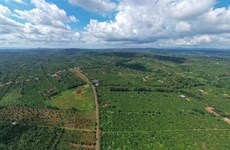Forex market to fluctuate until the end of the year
The exchange rate continued to increase over the last few days though
less strongly than at the beginning of October, with the VND/USD selling
rate reaching 21,400.
Although the rate is still well under the ceiling level, the trend is expected to attract businesses’ attention, as they have to guard themselves from the risks of exchange rate fluctuation and lending behaviour, especially since foreign currency credit increased by more than 20 percent during the first nine months of 2014.
Although the rate is still well under the ceiling level, the trend is expected to attract businesses’ attention, as they have to guard themselves from the risks of exchange rate fluctuation and lending behaviour, especially since foreign currency credit increased by more than 20 percent during the first nine months of 2014.
The exchange rate continued to increase over the last few days though
less strongly than at the beginning of October, with the VND/USD selling
rate reaching 21,400.
Although the rate is still well under the ceiling level, the trend is expected to attract businesses’ attention, as they have to guard themselves from the risks of exchange rate fluctuation and lending behaviour, especially since foreign currency credit increased by more than 20 percent during the first nine months of 2014.
Commercial banks may see an increase in foreign currency trading as the market fluctuates.
Regarding the forex market fluctuations in early October, State Bank of Vietnam representatives said the bank would regulate the system’s available capital in a reasonable manner to stabilise the exchange rate.
Interest in VND on the interbank market increased again following the move, especially the overnight rate surged from 1.5 percent per year to nearly 3 percent per year.
According to Dr Nguyen Tri Hieu, a banking specialist, the increase in the foreign currency exchange rate was less attributable to changes in supply and demand of foreign currency on the market, but rather to the mentality of traders.
However, the forex rate is likely to oscillate until the end of this year, he predicted.
Demand for USD over the next three months is expected to increase since imports and foreign debt payments often rise sharply during that period, Hieu said. Furthermore, speculators are just waiting for some negative information to continue creating fluctuations, he asserted.
Another economist said inflation in 2014 is predicted to stay low and remain controlled, which is considered a positive development. However, confidence in VND does not depend on the rate of the currency’s devaluation but rather the overall health of the economy, he said.
“Vietnam’s low inflation rate indicates a struggling economy, with a number of people lacking confidence in the strength of VND. They therefore pay attention to gold and USD, or other high-liquidity assets with a higher value than VND,” Hieu added.
According to a report issued by the National Financial Supervisory Commission (NFSC) on Vietnam’s economy during the first nine months of this year and September in particular, total demand increased, but it was not sufficient to make the economy bounce back.
The commission calculated that in September the core inflation rate was 3.12 percent, lower than the general rate of 4.62 percent and last September’s figure of 4.43 percent.
Total revenue from retail and services was higher than during the same period last year, but the growth was much lower than the more than 10 percent rate recorded in 2010 and 2011.
A commercial bank leader said small fluctuations will be seen on the forex market until the end of the year as the market brings itself in line with the supply and demand of VND and other investment channels.
However, the Vietnamese dong will increase slightly in value, which means the exchange rate could drop to a SBV purchasing price of 21,200 VND/USD, the leader said.
Meanwhile, SBV Governor Nguyen Van Binh recently affirmed that the bank would remain consistent in its targets. The entire banking system will keep a close eye on the development of the currency and forex markets to enable a flexible response, he said, adding that the bank would undertake all the necessary measures to stabilise the currency, forex and gold markets.
In order to ensure stability, the bank was ready to boost liquidity and intervene to stabilise the exchange rate within the trading band set out earlier this year, he said.
SBV will also prepare to roll out measures and currency policy tools to support the stability of the exchange rate and ensure the security of the banking system.-VNA
Although the rate is still well under the ceiling level, the trend is expected to attract businesses’ attention, as they have to guard themselves from the risks of exchange rate fluctuation and lending behaviour, especially since foreign currency credit increased by more than 20 percent during the first nine months of 2014.
Commercial banks may see an increase in foreign currency trading as the market fluctuates.
Regarding the forex market fluctuations in early October, State Bank of Vietnam representatives said the bank would regulate the system’s available capital in a reasonable manner to stabilise the exchange rate.
Interest in VND on the interbank market increased again following the move, especially the overnight rate surged from 1.5 percent per year to nearly 3 percent per year.
According to Dr Nguyen Tri Hieu, a banking specialist, the increase in the foreign currency exchange rate was less attributable to changes in supply and demand of foreign currency on the market, but rather to the mentality of traders.
However, the forex rate is likely to oscillate until the end of this year, he predicted.
Demand for USD over the next three months is expected to increase since imports and foreign debt payments often rise sharply during that period, Hieu said. Furthermore, speculators are just waiting for some negative information to continue creating fluctuations, he asserted.
Another economist said inflation in 2014 is predicted to stay low and remain controlled, which is considered a positive development. However, confidence in VND does not depend on the rate of the currency’s devaluation but rather the overall health of the economy, he said.
“Vietnam’s low inflation rate indicates a struggling economy, with a number of people lacking confidence in the strength of VND. They therefore pay attention to gold and USD, or other high-liquidity assets with a higher value than VND,” Hieu added.
According to a report issued by the National Financial Supervisory Commission (NFSC) on Vietnam’s economy during the first nine months of this year and September in particular, total demand increased, but it was not sufficient to make the economy bounce back.
The commission calculated that in September the core inflation rate was 3.12 percent, lower than the general rate of 4.62 percent and last September’s figure of 4.43 percent.
Total revenue from retail and services was higher than during the same period last year, but the growth was much lower than the more than 10 percent rate recorded in 2010 and 2011.
A commercial bank leader said small fluctuations will be seen on the forex market until the end of the year as the market brings itself in line with the supply and demand of VND and other investment channels.
However, the Vietnamese dong will increase slightly in value, which means the exchange rate could drop to a SBV purchasing price of 21,200 VND/USD, the leader said.
Meanwhile, SBV Governor Nguyen Van Binh recently affirmed that the bank would remain consistent in its targets. The entire banking system will keep a close eye on the development of the currency and forex markets to enable a flexible response, he said, adding that the bank would undertake all the necessary measures to stabilise the currency, forex and gold markets.
In order to ensure stability, the bank was ready to boost liquidity and intervene to stabilise the exchange rate within the trading band set out earlier this year, he said.
SBV will also prepare to roll out measures and currency policy tools to support the stability of the exchange rate and ensure the security of the banking system.-VNA













